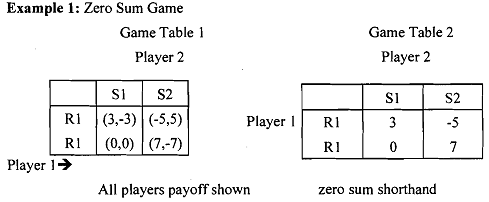Illustrating simultaneous move games:
Games are said to be of simultaneous move if players move without the knowledge of what the other players have chosen to do. Thus, when the players take their decisions at the same point of time the game is a simultaneous move game. A game is also called the simultaneous move when the players chose their decisions in isolation, with no information on what the other player is doing or will do. For this reason, simultaneous move games are often regarded as games of imperfect information or imperfect knowledge.
Simultaneous move games are most often represented in normal form using a game table or payoff table. The table lists the payoffs to all players that will be generated after the strategic interaction among the players. If the interests of the players are wholly in opposite direction, any benefit gained by one player is loss to the other. This type of interaction guarantees that payoff to the players will add up to a constant value (often zero). Therefore, these kinds of games are called constant sum game (zero sum game when the payoffs add up to zero). Consider the following example

In example, the game table shows the payoffs that will accrue to the players land 2, after the game is played. The player1 has strategies Rland R2 at her disposal whereas player 2 has strategies S1 and S2 at her disposal. The first of the numbers in each cell separated by a comma represents the payoff to the player 1 and the second number represents the payoff to the player 2. Clearly, it is a zero sum game as the payoffs in each cell adds up to zero. Therefore, in this type of games if we know the payoff of one player we can deduce the payoff of the other player. The game Table 2 represents a shorthand notation of the same game, where only the payoff to the palyerl is shown. But there could be games in which players interests are not contradictory, as in zero sum games. These type of games are called constant sum games. The game table representing these type of games, therefore, must show the payoffs to each player in each cell as in the following example:
Example : Variable Sum Game
